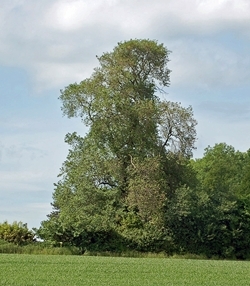The elm
 As I a child the view from my bedroom window was across a valley dominated by elm trees – and I mean dominated. Not only were they numerous but also mature elm can reach a height of 30 metres, so they were extremely obvious. Great examples of what a landscape full of tall elm trees looked like are well recorded in art, perhaps most famously by looking at John Constable’s The Cornfield (1826) and Salisbury Cathedral from the Bishop's Ground (1823), where elm trees boldly feature.
As I a child the view from my bedroom window was across a valley dominated by elm trees – and I mean dominated. Not only were they numerous but also mature elm can reach a height of 30 metres, so they were extremely obvious. Great examples of what a landscape full of tall elm trees looked like are well recorded in art, perhaps most famously by looking at John Constable’s The Cornfield (1826) and Salisbury Cathedral from the Bishop's Ground (1823), where elm trees boldly feature.
We knew them as the English elm (Ulmus minor var. vulgaris) which is a deciduous tree native to southern and eastern Europe. At this time of year they became particularly noticeable, as their leaves turned a golden yellow. In those days, a setting sun late on an October afternoon would pick out these yellow leaves, turning the whole landscape into a fiery golden blaze of light, momentarily creating a breathtakingly beautiful scene… before it was gone.
Despite its common name, there is some debate as to whether or not the elm is native to this country as it may have been introduced to the UK by Bronze Age farmers, although some do believe that it might just be native to southern England only.
English elms are hermaphrodites, meaning both male and female reproductive parts are contained within the same flower. Flowers are coloured a dark pink through to red and hang in tassels, appearing in February and March. Once pollinated by wind, the flowers develop into tiny winged fruits, known as samaras, which are then also dispersed by the breeze.
Elm wood is strong and durable with a tight-twisted grain and is resistant to water, so that before metal was widely available, many English towns had water mains supplied from pipes made from elm wood, including Bristol, Reading, Exeter, Southampton, Hull and Liverpool. It has also been widely used to make boats and boat parts, furniture, wheel hubs, floorboards and was the preferred choice for making coffins. Interestingly, elm was also used in the construction of the original London Bridge.
There are many types of elm, including the relatively common Wych elm. However I’m not going to be brave enough to start to try and sort this out here! The famous Cambridge University “tree guru” Oliver Rackham, describes elms as the most difficult genus in the entire British flora, adding that 'species and varieties are a distinction in the human mind rather than a measured degree of genetic variation'.
Elms are of course highly susceptible to Dutch elm disease, a fungal infection that has devastated populations since it arrived in the UK in the 1960s and has now made a mature elm tree a rare sight, although plenty of elm still survives in hedges as suckers. The disease is caused by a micro-fungus transmitted by two species of elm-bark beetle which act as vectors.
The disease affects all species of elm native to North America and Europe, but some Asiatic species have evolved anti-fungal genes and are resistant. This gives us some hope that we may be able to introduce resistant elm trees back into the landscape. This could also be of great importance for the White-Letter Hairstreak butterfly, whose caterpillars feed only on elms and accordingly, has declined dramatically since Dutch elm disease arrived in the UK.
Trials in Hampshire undertaken by Butterfly Conservation have found that along with the Asiatic species, there is an Italian cultivar called morfeo which has outperformed all others and so they are now working closely with the Forestry Commission to plant these trees across parts of Hampshire.
So, although I will not be around to see it, maybe the British landscape will once again look just how it did when I was a child, dominated by these tall, proud trees, cloaked at this time of year in their autumnal yellow.
Peter Thompson
Advisory
Read more from Peter Thompson at the Fresh from the Field blog.

Download Peter Thompson's essential 26-page book, featuring beautiful photography and detailed profiles of Britain's wildlife
Download FREE >